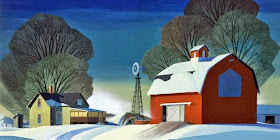Dateline: 18 December 2014
 |
A Depression-Era farm Family.
Poor? Perhaps in Babylon, but not in reality.
(How can those children be smiling!) |
Eleutheros had a blog titled How Many Miles From Babylon. Some of you reading this may remember it.
Eleutheros apparently valued his privacy. His name was a pseudonym. It means 'free man' in Greek. He never showed a picture of himself or his family.
Eleutheros lived a self reliant, agrarian life in the mountains of Tennessee. He never said exactly where in the mountains of Tennessee.
Eleutheros blogged from June of 2005 to October 2006. He was an excellent writer and I thoroughly enjoyed reading his essays. But the writing stopped. In time, How Many Miles From Babylon disappeared from it’s location on the web.
If Eleutheros has reemerged on the internet in a different format, I don’t know of it. Maybe someone else knows and can share the information here.
I got to thinking about the writings of Eleutheros and decided to see if I could find his old blog at the WayBack Machine web archive, and I did. The blog is gone from where it was, but it was saved. Amazing.
So I've decided to post an example of one of the blogs of Eleutheros for you here. His writings should not be lost. I'm doing this without permission, of course. I will remove it if the need arises. And I may take the liberty in the future of posting some other excerpts from this free man, Eleutheros.
The following essay was originally posted on December 3, 2005 at How Many Miles From Babylon....
I have the advantage of understanding this century because I understood that last so well. And I understood the last becasue of my insight into the one that came before. Not personally, I'm not quite that old. But when I was a teenager, my great-grandmother was still with us. She was past 100 years old by then, having been born just a couple of years after the War for Southern Independence. Ah, if one could go back and ask her things now! But even as a 13 year old there was much to take note of.
My mother was raised in very rural Lee County, Virginia, and was a small child during the Great Depression. She was two years old in 1929 and so the depression economics was all she knew until she was grown. When she and my father would wax nostalgic about the hard times, I asked her what 'hard times' meant.
"Did you not have enough to eat?"
"Oh, we always had plenty to eat, we lived on a farm just like almost everyone else in those days. It was common stuff, cornbread, beans, greens with fatback, milk, and such but there was certainly plenty enough."[This, by the bye, in a family of a widow with sixteen children (at the time)].
"Did you not have enough clothes?"
"Nothing fancy and one pair of shoes, but we had clothes enough."
"Were you cold?"
"Don't recall ever being cold."
"What did it mean then that there was a depression? What were hard times?"
"Oh, it was because no one had any money."
So I talked to my paternal grandmother who was born in the late 1880's and who would have known the world before the hard times set in.
"What was the depression like?"
"Oh, hard times."
"Were you all in this hollow, hungry, cold, ill-clothed?"
"No, no, ate then about like we eat now." [Appalachian peasant fare].
"Then why were times hard?"
"Because no one had any money."
My recources were deep and rich then. I went in to see 'Mommy-Mamaw', the Applachian term of endearment for the ancient matriarch of the fourth generation. She sat up in her bed and spoke in the whistling whisper of a voice from another century and listened patiently to my question.
She told how just before the crash in '29 there was a brief spate of coal and logging activity and the silver dollars that was the day's wage for a working man flowed for a while. She told how she commanded the same wage as a skilled cook in the logging camp and how she'd fallen from the horse on her way home once and broke her pelvis and so had not had any more children besides my grandmother. You could tell by the expression in her ancient visage that her emotions were mixed, only the one child, and yet here was I, the next to the youngest great-grandchild of a considerable tribe and clan.
"But what about not having any money?"
The question brought her back from her reverie and her high Cherokee cheekbones seemed to raise up in a crinkled smile as her pale grey eyes lit up with amusement.
"Lord, child, nobody in these hills ever had any money."
My parents were dedicated post-war suburbanites but my grandparents still lived a horse-drawn eighteenth century lifestyle. The picture that emerged from my quizzing of my elders was that before the 1920's, the economy in this part of the world was subsitence and direct use. Money was not necessary, not much of it anyway. A person with a cow and few pigs and chickens and good stand of corn was well off.
Then in the 30's electricity came to the hollow. Parallel to the hollow where my father was raised (Crooked Branch Hollow) was a far more arable draw (Hamblin Creek Hollow) which was abandoned and is now reverted to forest because the power company ran the electric lines up the former but not the later.
This was in the wake of the rampant consumerism of the 1920's that helped bring about the depression in which washing machines and refigerators were being pushed on the public. Now by comparing themelves with people who had electricity, washing machines, refrigerators, and automobiles, the pastoral household was poor in comparison and by those standards.
The poverty remembered by my parents did not come about as a result of a loss or diminishing of the livelihood of the folk, it came about because there was a new and external standard to which they did not measure up.
==========
P.S. I blogged about Eleutheros' advice on debt back in 2008. Here is the link: Eleutheros on Debt


















